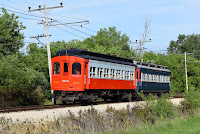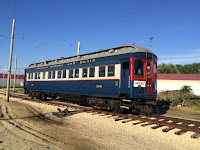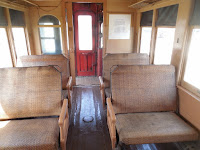The 308 and 319 are scheduled for passenger service this weekend, and there were several things I noticed from last time that I wanted to fix before then, as well as various things on the 36 and 309. So this is a report on two days' worth of work.

Several parts on 319 had been removed for painting the interior, and still needed to be put back, such as ticket clips (L) and the brass plates on a bulkhead door (R).

And one light circuit needed a new bulb. (It doesn't really look like this, but I couldn't fix the exposure.) I also rang out the light circuits in the 308. Some repairs will be needed, but that's a relatively low priority, so I made sure the defective circuits were disconnected.


One of the ceiling patch pieces fell out and broke into three parts, so I took it home and epoxied it together. After careful installation, and first primer, it looked like this:
The handrails on the bottom of the trap doors on the 319 had very bad paint. It doesn't bother me, but some of our visitors might be annoyed by the rough surface, so they were sanded down to bare metal. Then they just looked rusty, so I repainted them.
Another thing I wanted to work on was fixing the bent coupler on the 309. The drawbar at the #1 end has always been bent, since 1962, I believe. When the scrap dealer was moving cars around in the yard at Wheaton to get them ready for scrapping or preservation, they evidently got banged around pretty hard. As a result, we generally try to keep the #1 end of the car at the end of the train, but it would be good to fix this.
I could ask the Steam Dept. guys to straighten the shank in their big press, but it could possibly break or at least be weakened in the process, so I started to look for replacements. We have a good number of spare Van Dorn drawbars, but they're all the wrong size. After careful measurement, it looks like one from the 321 should work OK, so I may try to swap couplers sometime this summer.
The 36 has lettering on only one side, and I had never finished outlining it, so that got done this morning. On Saturday I will turn the car around if possible to start on the other letterboard.
And on the roof, I put in some new leather cable straps to replace ones that had broken.

The side sill on one side hadn't been painted yet, so that got done.
And all of the tools and paint cans were removed from inside the car, so we can start on inspection next week, I hope. The last one!

Oh, and the patch piece in the 319 needed some finish paint. I just hope this doesn't fall out again during revenue service. If it does, I'm blaming the motorman!
A lot of civic improvements are underway at the Museum also, but I guess I didn't take any pictures of them. You'll have to see for yourself. And as usual, several other projects were being pursued. Today we'll choose just one of them.


Norm and Jeff were busy getting ready to apply the final coat of paint to the roof of the 28. Here are some detail shots.


Well, that was fun. It's always nice to have a lot of variety.






















































